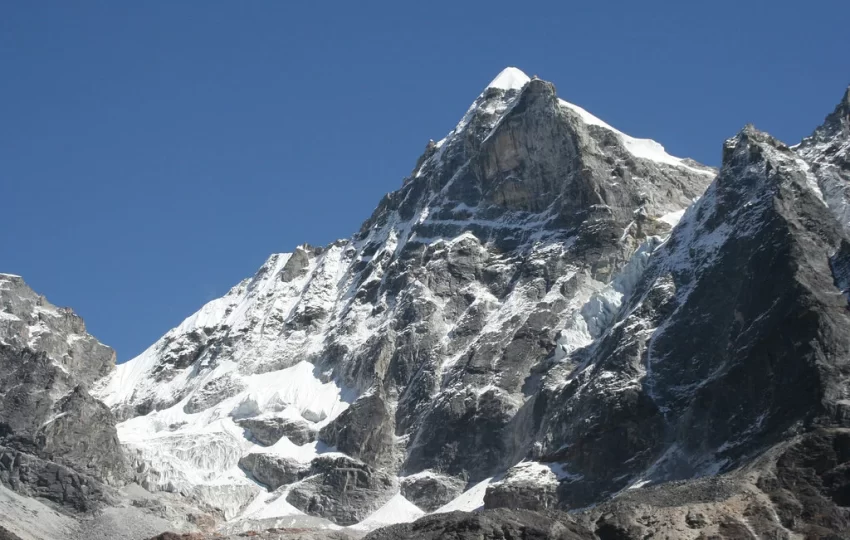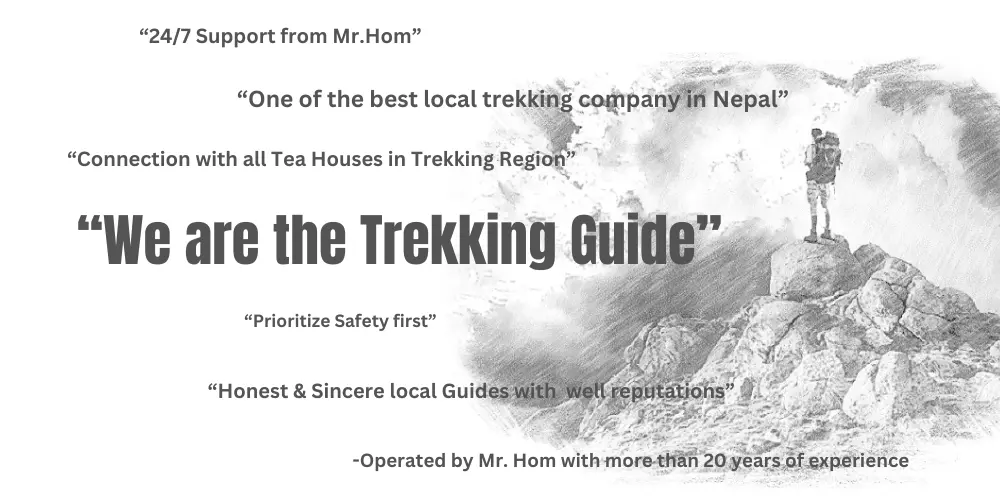Kyajo Ri Peak Climbing offers intrepid adventurers a remarkable opportunity to conquer a less-traveled 6,186m peak in the heart of Nepal's Khumbu region. This expedition combines the thrill of scaling a semi-technical peak with the experience of trekking through awe-inspiring landscapes.
With its challenging ascent, mixed terrain, and breathtaking vistas, Kyajo Ri Peak promises a truly unforgettable adventure for those seeking to push their limits
Highlights of Kyajo Ri Peak Climbing
Unique Mountain Challenge: Kyajo Ri stands as a technical peak, presenting a distinctive challenge with its steep mixed terrain. The climb encompasses a blend of snow, ice, and rock, requiring basic knowledge of crucial climbing techniques.
Spectacular Scenery: Traverse through stunning landscapes, from lush valleys to glacier-fed lakes, while enjoying panoramic views of the Himalayas, including Everest, Lhotse, and Makalu.
Challenging Summit: Ascend the challenging slopes of Kyajo Ri, featuring steep sections with up to 55-degree inclines. Summiting this peak demands mental resilience, determination, and teamwork.
Expert Guidance: Highly professional guides with extensive experience in mountaineering and climbing lead you throughout the journey. They provide instruction on essential skills and ensure your safety at all times.
Cost Inclusion & Exclusion of Kyajo Ri Peak Climbing:
Here is the cost inclusion of Kyajo Ri Peak climbing:
- International Airport Pick-Up and Drop
- Accommodation in Thamel, Kathmandu in Blue Horizon hotel on the basis of Twin Sharing with Bed & Breakfast service
- Welcome Dinner
- Permits for Kyajo Ri Peak Climbing, Sagarmatha National Park entry fee, Pasang Lhamu Rural Municipality Entry fee & any other required fee.
- Garbage Deposit fee, Luggage clearance fee up to 30 kg
- Kathamndu-Lukla & Lukla-Kathmandu Flight or Ramechhap-Lukla & Lukla-Ramechhap flight (Based on the off-seasons and peak-seasons)
- Kyajo Ri Peak Expedition Map
- Staff Member Insurance, Members luggage up to 60 kg carried by porters or Yaks
- Expedition Stuffs Transportation via air cargo & porters/Yak
- All accommodation services during trekking & tent facilities during climbing
- Base Camp Equipment like Tents, shower tents, kitchen tents, dining tents, tables, chairs, kitchen utensils, & other important equipment.
- Full board Meals: Breakfast, Lunch, and dinner. (Veg & Non-veg both available) During the whole trek & expedition
- Government Liaison Officer | Daily allowance, Equipment allowance for Liaison Officer, air ticket & 3 meals
- Walkie-Talkie for communicating during the expedition
- 1 Solar panel or Generator for battery charge
- Government Licensed Sherpa guide for climbing, Sherpa guides Salary, Allowance, Equipment, Food, and Clothing.
- Porter for every 2 climbers during the trek
- Oxygen Bottle and mask in Base Camp for emergency purposes (subjected to charge)
- Correspondence in evacuation or Heli-evacuation based on travel insurance
- Weather Forecast Report
- Company Duffel Bag & T-Shirt
- Summit Certificate
- Farewell Dinner in Nepali Restaurant
Here are the cost exclusions of Kyajo Ri Peak Climbing:
- International Flight Fare: to or from Kathmandu
- Nepali Visa Fees or Renewal fees
- Lunch and dinner during stay in Kathmandu Blue Horizon
- Adding any extra days to the package
- Extra Nights in Kathmandu in case of early arrival or late departure
- Travel/Trekking Insurance
- Drone permits
- Tipping to any staff members
- Personal Expenses
Kyajo Ri Difficulty:
The ascent of Kyajo Ri Peak poses a challenging yet achievable endeavor for seasoned climbers and adventurers. Graded as 7-8 on the difficulty scale, the climb demands a high level of physical fitness, mental resilience, and technical prowess. Here's a closer look at the factors that contribute to the difficulty of Kyajo Ri Peak Climbing:
Mixed Terrain: Kyajo Ri's technical nature lies in its mixed terrain, involving a combination of ice, snow, and rock. Climbers must be proficient in using crampons, ice axes, and rope techniques to navigate these diverse conditions.
Steep Inclines: The climb features steep sections with slopes ranging from 50 to 55 degrees. Climbers must be comfortable with ascending and descending such challenging gradients, especially while roped together.
Acclimatization: Acclimatization is crucial due to the high altitude. The itinerary includes gradual ascents and rest days to acclimate your body to the thin air, reducing the risk of altitude-related illnesses.
Weather Conditions: The weather in high-altitude regions can be unpredictable and harsh. Climbers must be prepared to face changing weather conditions, including snowfall, wind, and low temperatures.
Why Kyajo Ri?
Choosing Kyajo Ri for your peak climbing adventure comes with a host of compelling reasons:
Less Crowded: Unlike more popular peaks, Kyajo Ri offers a quieter and more serene environment. You can enjoy the mountains without the bustling crowds, creating a more personal and intimate experience.
Unexplored Territory: Kyajo Ri remains relatively unexplored and unclimbed, making it an exciting destination for adventurers looking to blaze their own trail.
Spectacular Views: The summit of Kyajo Ri rewards climbers with breathtaking panoramic views of some of the world's highest peaks, including Everest, Lhotse, Makalu, and many more.
Cultural Immersion: The trek to Kyajo Ri takes you through charming Sherpa villages, monasteries, and markets, offering a chance to immerse yourself in the rich culture and traditions of the Himalayan region.
Skill Development: Climbing Kyajo Ri requires honing technical skills such as ice axe arrest, roped travel, and crampon techniques. It's an opportunity to expand your mountaineering capabilities.
Kyajo Ri Route Overview:
The route to Kyajo Ri Peak unveils a mesmerizing journey through diverse landscapes, from Sherpa villages to glaciated terrains. Here's an overview of the route:
Kathmandu to Lukla: Your adventure begins with a scenic flight from Kathmandu to Lukla, the gateway to the Everest region. Lukla's Tenzing Hillary Airport is a remarkable feat of engineering that sets the tone for the adventure ahead.
Renjo La Pass: Crossing the challenging Renjo La Pass (5,340m/17,520ft), you'll encounter breathtaking panoramic views of the surrounding peaks. The pass is a dramatic high point of the journey, offering a vantage point to absorb the grandeur of the Himalayas.
Kyajo Ri Base Camp: As you make your way to Kyajo Ri Base Camp, the landscape shifts, revealing the towering peak that awaits you. The base camp provides a vital resting point and serves as your launching pad for the summit push.
Summit Ascent: The climb to Kyajo Ri's summit involves ascending steep slopes of snow, ice, and rock. The route requires technical skills and steady progress, with the reward of reaching the pinnacle and soaking in awe-inspiring panoramic views.
Descent and Return: Following the successful summit, the descent takes you back through familiar landscapes, allowing you to reflect on your accomplishment. The journey concludes with your return to Lukla and a flight back to Kathmandu.
Best Time for Kyajo Ri Peak Climbing:
The timing of your Kyajo Ri Peak climbing expedition is crucial for a successful and enjoyable experience. The best seasons to undertake this adventure are:
Spring (March to May): Spring offers stable weather, clear skies, and milder temperatures. The snow begins to melt, making the trail more accessible and providing excellent climbing conditions. The colorful blossoms add charm to the trek.
Autumn (September to November): This season is another optimal window for climbing Kyajo Ri. The weather is generally dry and stable, and visibility is excellent. The skies are clear, and the landscapes are adorned with vibrant foliage.
During these seasons, the chances of encountering clear mountain views, manageable weather conditions, and stable trails are at their highest. However, it's important to note that even during the best seasons, the weather in the mountains can be unpredictable, so being well-prepared is essential.
FAQ:
How difficult is the Kyajo Ri climb?
Kyajo Ri is graded as strenuous (7-8) due to its technical nature. It involves steep ascents on mixed terrain of ice, snow, and rock. Basic rock climbing, roped travel, crampon techniques, and ice axe arrest skills are required.
What is the climbing route for Kyajo Ri?
The normal route for Kyajo Ri is from the south face, involving steep ascents on 50-55-degree slopes of snow and ice. The route is technical and requires confidence in walking with crampons, using abseiling and ascending devices and being able to walk together on the same rope.
What is the guide-to-client ratio on climbing days?
The guide-to-client ratio is 1:3 on summit days. This ensures personalized attention, safety, and effective coordination during the climb.
What are the accommodation arrangements during the trek and climb?
Accommodations are provided in lodges and tea houses during the trek. During the climb, tented accommodations are set up at Base Camp and higher camps for a comfortable stay.
Are meals included during the climb?
Yes, meals are included throughout the trek and climb. Nutritious meals are prepared by our experienced cooks to keep you energized during the expedition.
Will drinking water be provided?
Safe drinking water is essential. We provide boiled and purified water during the trek and climb. Carrying water purification tablets or a water filter is also recommended.
Is travel insurance required for the climb?
Yes, travel insurance is mandatory. It should cover high-altitude climbing, emergency evacuation, and medical expenses. Please ensure your insurance is comprehensive and includes the Kyajo Ri climb.
Will I have to carry my own gear?
You'll be responsible for carrying your daypack during the trek. Porters will carry your main luggage. On climbing days, you'll need to carry essential climbing gear.s K
Is it Kyajo Ri Peak Climbing or Kyajo Ri Expedition?
As Kyajo Ri Peak is under 6,500 meters with only 6,186 meters altitude, it is indeed a peak climbing.











